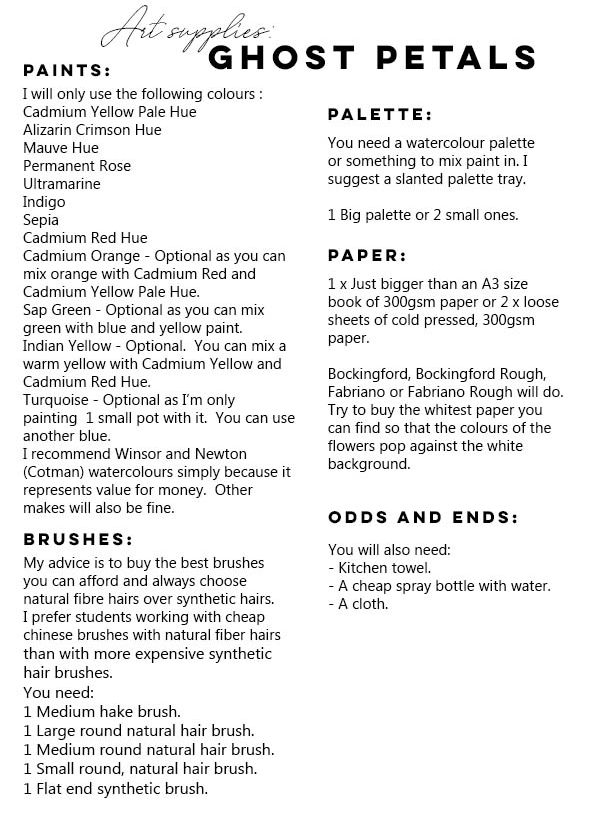


ghost petals
Watercolour course
this course is for you if:
- You have some experience with watercolours;
or
- You’ve done a few paintings but feel that you lack some of the intermediate skills to paint with ease
or
- You want to paint loose watercolours but your paintings are all too perfect and precise.
What you will learn
The course material
In this online course, I will show you how to paint hard-edged flowers in a softer, looser way with visible watercolour effects.
Lesson #1:
In the first lesson, I give you 7 hints and tips that will allow you to easily copy this style of painting as well as explain the two approaches to this style of painting.
Lesson #2:
In this lesson, I introduce you to a 4 step approach that will ensure that you can duplicate my results easily. I break up the steps in manageable parts.
Lesson #3:
I will demonstrate a more direct, 2-step method for clumps of flowers and explain how you can apply this method to your own painting.
You will need:
brushes:

The two most important factors that determine the ease with which you’ll be making marks with watercolours are the abilities of your brush and the quality of the paper that you work on.
My advice is to buy the best brushes you can afford and always choose natural fiber hairs over synthetic hairs. I prefer students working with cheap chinese brushes with natural fiber hairs (photo below) than with more expensive synthetic hair brushes.

palette:

You will need some kind of container to dilute your paints in.
There are various options available but even small saucers will work. I prefer slanted palettes.
paper:
1 x Just bigger than an A3 size book of 300gsm paper or
2 x loose sheets of cold pressed, 300gsm paper. Bockingford, Bockingford Rough, Fabriano or Fabriano Rough will do. Try to buy the whitest paper you can find so that the colours of the flowers pop against the white background.
And lastly
odds & ends:
paints:

I will only use the following colours : Cadmium Yellow Pale Hue
Alizarin Crimson Hue
Mauve Hue
Permanent Rose
Ultramarine
Indigo
Sepia
Cadmium Red Hue
Cadmium Orange - Optional as you can mix orange with Cadmium Red and Cadmium Yellow Pale Hue.
Sap Green - Optional as you can mix green with blue and yellow paint.
Indian Yellow - Optional. You can mix a warm yellow with Cadmium Yellow and Cadmium Red Hue.
Turquoise - Optional as I’m only painting 1 small pot with it. You can use another blue.
You will also need:
- Kitchen towel.
- A cheap spray bottle.
- I like to keep a cheap cloth on hand to absorb excess water. A piece of an old towel will do.
- Some clean water and a place to dump dirty water. I use a 2L container with clean water and a cut-off container to dump dirty water in.

You can order your supplies online from Artsavingsclub (South Africa only) in a pre-packed bundle or you can order single items if you already have some of the supplies.
Click on the link below.




